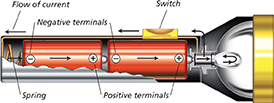20.2 Electric Current and Ohm's Law
Reading Focus
Key Concepts
 What are the two types of current?
What are the two types of current? What are some examples of conductors and insulators?
What are some examples of conductors and insulators? What factors affect electrical resistance?
What factors affect electrical resistance? What causes an electric current?
What causes an electric current? How are voltage, current, and resistance related?
How are voltage, current, and resistance related?
Vocabulary
electric current
direct current
alternating current
electrical conductor
electrical insulator
resistance
superconductor
potential difference
voltage
battery
Ohm's law
Reading Strategy
Predicting Copy the table below and write a prediction of what electric current is. After you read the section, if your prediction was incorrect or incomplete, write what electric current actually is.
| Electric Current Probably Means | Electric Current Actually Means |
|---|---|
a. | b. |
If you've ever tried to fix a flashlight, you know there are several parts to check. The batteries may be dead, or the bulb may have burned out. The switch could be broken, or the spring might be corroded. If even one part isn't functioning, the flashlight won't light.
Electric Current
As you can see in Figure 7, the parts of a flashlight form a continuous path through which charge can flow. This continuous flow of electric charge is an electric current. The SI unit of electric current is the ampere (A), or amp, which equals 1 coulomb per second.
 The two types of current are direct current and alternating current. Charge flows only in one direction in direct current (DC). A flashlight and most other battery-operated devices use direct current. Electric current in your home and school is mostly alternating current.
The two types of current are direct current and alternating current. Charge flows only in one direction in direct current (DC). A flashlight and most other battery-operated devices use direct current. Electric current in your home and school is mostly alternating current.
Figure 7 A complete path is required for charge to flow in a flashlight. Batteries must be placed so that charge can flow from negative to positive, passing through the bulb.
Interpreting Diagrams What purpose does the spring at the base of a flashlight have?
 dd
ddAlternating current (AC) is a flow of electric charge that regularly reverses its direction.
In a flashlight, electrons flow from the negative terminal of the other battery. But notice that the current is in the opposite direction. This is because scientists define current as the direction in which positive charges would flow.






